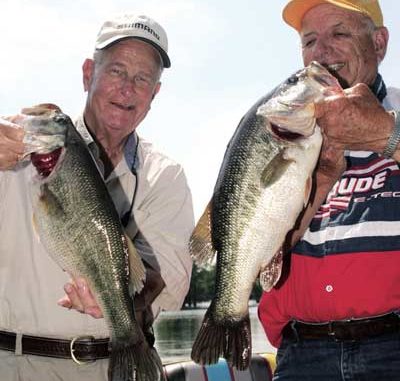
Deep water isn’t the only place to look for Moultrie’s largemouths during the hottest months. They’ll bite in the shallows, too, for fishermen who know where to look.
Strategies for bass fishing are as varied as the anglers who target them. That’s particularly true on Lake Moultrie during hot weather.
While this huge body of open water is full of drops, humps and ledges that hold bass during the summer, it is also ringed with plenty of shallow, bass-holding, cover.
Some anglers have learned that the shallow cover in Lake Moultrie is as productive in the summer as in the spring. The key to success is keeping your options open.
Inky Davis has guided on Lake Moultrie for 35 years; one of his favorite places to fish during July is the shallow cover that surrounds the lake.
“I think shallow water one of the most overlooked summertime bass hotspots on Lake Moultrie,” Davis said. “Fishing during the summer is often viewed as an open-water fishery. That has been and is still an extremely effective technique; it’s certainly not the only successful summertime pattern. The mid-lake areas have actually become more difficult to fish successfully, unless you know the precise location of underwater cover. A lot of the open-water bass fishermen have sunk brush along those humps and ledges in recent years that will attract and hold bass, and they have the exact coordinates of those structures on their GPS. Knowing the location of those places, the open-water areas provide outstanding fishing.”
Davis said that years ago, plenty of natural cover existed on the humps and ledges to hold largemouths, but over time, a lot of it has deteriorated, rotted or silted over, and pinpointing where the bass will be located can be difficult if you don’t know where it’s located.
Jim Marshall, a Manning resident who once guided on Florida’s famed St. John’s River, agrees with Davis’ assessment.
“I enjoy shallow-water fishing and know that it can be productive year round,” he said. “I’ve taken what I learned when bass fishing the shallow rivers and lakes in Florida and applied it to the Lake Moultrie and Lake Marion. I’ve enjoyed some highly productive days on Lake Moultrie in hot weather, and that includes catching some really big bass. The key, as it is any time of the year, is to get into areas where there’s plenty of forage and find the right speed and depth for the lure you’re fishing. I am not a lover of soft plastics, but I realize sometime they are extremely productive, and this is the time of year for bottom-bumping plastics.
“I’ll usually fish the spinnerbait and crankbait first,” he said. “I often fish with Inky Davis, and he is more of a worm and bottom-bumper type fisherman during the summer, but that does make us work well as a team when we fish together. But if I start getting behind by a couple 5-pound fish, I’ll rig a worm in a heartbeat.”
Marshall said productive, shallow areas around Lake Moultrie produce well during the summertime.
“One of my favorite shallow-water areas is the Hatchery near Moncks Corner,” he said. “There’s a great deal of shallow cover there, but that’s only part of the reason I like it so much. There’s a slightly deeper channel or canal around the Hatchery area. During July, I do not stray far from that deeper water. Most of the bass will be close to that deeper water, holding on trees or other woody or vegetative cover. When the conditions are right in terms of depth, proximity to deeper water and forage being present, you’ll often find more than one good bass in a specific area. Catching a couple of quality fish pretty quick is a real possibility. As a rule, I seldom get more than 50 to 100 yards from the deeper canals at this time of the year.
“A good bit of native vegetation grows there, and it will hold fish during the summer, as well as cypress trees,” Marshall said. “Unless you see fish schooling, you’ll need to work out a pattern on a daily basis. I’ve found that where the forage goes, so do the largemouth. Match the hatch is a good recommendation, because when I can see what the bass are feeding on, I do try to match it in size and color of lure and it often makes a big difference.”
Davis said that the Russellville Flats are another shallow-water hot spot he recommends during the summer.
“This area gets considerable pressure during the spring, but by July, not many bass fishermen are back in there,” Davis said. “I key on two specific physical features for success. One is to find the areas of slightly deeper water. Old inundated pockets of slightly deeper water, and also the blackwater ponds, are key areas. Even six inches to a foot change in depth can be significant. The second key is to fish the outside woody cover. If I’m fishing around cypress trees, I’ve found that I’ll catch far more fish at this time of the year on the point trees nearest the deeper water. I’ll fish back in the trees a little way, but not far unless I’m getting consistent action.”
Davis said that getting on the water early can be a key to getting into big fish during hot weather.
“I’ll work shallow flats with stumps and logs, as well as shallow points that drop into deeper water,” he said. “These places can be great early or late in the day.”
Davis said that moving toward the deeper water is always a good bet if the shallow water action is slow.
“One of the first places I’ll fish if the shallow water is not productive will be the rip-rap areas on Lake Moultrie,” Davis said. “First, the water is deeper, and by fishing at the base of the rip-rap, there’s a defined breakpoint in the depth to which bass can relate. Second, and probably just as important, is that where this rip-rap exists, the fill for the rip-rap was dug from the lake right at the base of the rocks. That forms a slightly deeper ditch that parallels the rip-rap. Not all of the rip-rap areas have it, but locate the ones that do, and you have a potential July bass hotspot.
“The bass will move up the rip-rap toward the shallow water under certain conditions and can be taken shallow on topwater lures and shallow crankbaits,” Davis said. “This technique is particularly effective on cloudy or rainy days. As a rule, I focus my efforts at the base of the rip-rap. This can be a deep-diving crankbait heaven when you find the bass stacked up on these areas.”
Davis said wind can play a crucial role in the productivity of rip-rap fishing.
“When the wind is blowing hard right into the rip-rap area, you can bet baitfish will usually be blown into the area,” Davis said. “This is a prime time to hit these spots. With plenty of forage, the bass are likely to be in a feeding mode.”
Whether the Diversion Canal is considered part of Lake Moultrie can be debated, but the fact that largemouth bass are caught there in good numbers and big sizes throughout the summer is not debatable according to Marshall.
“The Diversion Canal has a lot going for it during the summer months,” he said. “First, there’s current, and where you have current you’ll have plenty of forage at this time of the year. I enjoy fishing the canal area, and fishing the lower end of the canal toward the Lake Moultrie side is an extension of the lake as far as I’m concerned.
“Deep-water access exists in the middle of the canal, but usually, I’ll find the bass reasonably shallow,” he said. “I fish the small cuts and points along the edge of the canal. These are areas where the fish can hide and ambush forage. Even the small pockets and points will be enough to hold fish. When current flows through the canal, there will be eddy pockets of water formed, and that’s where you can often find feeding largemouth.
“I like to work these areas with crankbaits, so I can cover a lot of water quickly,” Marshall said. “But don’t bet the whole farm on a crankbait as the only productive lure. Sometimes soft plastics will be the key; at other times, spinnerbaits will work. I’ve also caught plenty of fish casting a white bucktail and working it around these places. Finally, if the fish are holding deeper, you can vertically jig spoons and make good catches. It’s a versatile bass-holding area, but the fisherman has to often be versatile in presenting the lure to the fish to meet the unique circumstances of current, water color and the depth the fish are holding.
“I make fishing the Diversion Canal part of my regular routine of fishing Lake Moultrie, not a last resort-type situation,” Marshall said. “This can be a very productive way to catch some 4- to 6-pound fish at this time of the year.”
Marshall said that the old canal that was dug by hand before the lakes were impounded is another prime area.
“This old canal is well marked on most maps and is easy to find with the depthfinder,” Marshall said. “There are some bridge crossings, and the remains of those, mingled with the deep water of the old canal, are prime places to work soft plastics for big largemouth in July. With a good sonar unit, you can also track along the edge of this old canal and locate some man-made cover placed along it over the years. Some of these places can be extremely productive.”
The final scenario is to fish at night, and Davis said that can be an explosive opportunity.
“Topwater lures such as buzzbaits work extremely well during the summer months,” Davis said. “It’s obviously more difficult working around trees at night without constantly snagging, so I usually opt for fishing around grassy vegetation and along the edges of stump rows or fallen trees. Also, fishing around lighted piers with soft plastics or crankbaits can be a great way to hook some quality largemouth. Cranking the rip-rap areas at night is often very productive as well. “
This summer, don’t get locked into just deep-water thinking on Lake Moultrie. With so many options to consider, pick the ones that suits your style of fishing and catch those hefty Lake Moultrie bass.

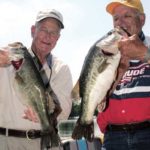
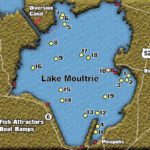
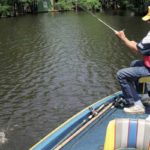
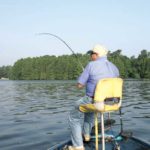
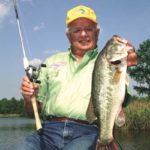
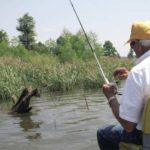
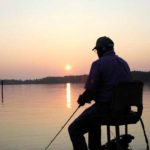



Be the first to comment